Mary Klug, Deb Wintrip, and Simone Haughton
Owl Child Care Services–Lincoln Road
Waterloo, Ontario
2015
The preschool Garden Project started mid-April 2015, while the new shoots where coming up out of the ground. The project lasted until late August 2015, when the harvesting of our garden was completed. The preschool children ranged from 2.5 to 4 years old. The staff present during this project was Mary Klug, Deb Wintrip, and Simone Haughton, all registered early childhood educators.
Phase 1: Beginning the Project
When spring approached, the preschool room took many neighborhood walks because of the rain. As the sun shone and the snow melted away, the children noticed a change in the garden outside the front of the church. Through all that mud they noticed “things” coming up. Camilo shouted, “Look.”
Showing interest, the teachers stopped and observed what was there. Questions started to form as the children explored the muddy ground that was covered in leaves. As the children were bending down and touching the ground, they seemed curious of the shoot that appeared. Deb asked, “Hey guys, what do you think these things are called?”
The children had some of their own ideas on what this sprout could be. There were weeds, flowers, oranges, garbage, broken leaves, food, and grass. As we continued on our walk up Lincoln Road past the schoolyard, the children noticed people in the yard working in little boxes. We learned that these boxes are small gardens that other people in the neighborhood use to plant fruits and vegetables. We found out that this is called a community garden.
We observed these people using a variety of tools, one being a long green spikey pick. During our conversations on the walk, the teachers noticed that the children were asking a lot of questions about plant growth, types of plants, types of foods you can grow, and where a garden can be planted. Thijm told us that his mother plants peppers and he helps her at home, but not now because it is too cold. This conversation gave the children the idea to plant something at Owl.
The teachers thought we could turn this into a project. On our return walk, the teachers and children discussed how we would get started and what we would plant. Once we got back to school, the teachers noticed children in dramatic play, preparing meals for one another, and stating that their meals were grown in their garden. During our outdoor time, we observed children digging in our garden beds. Deb decided to pull out some of our child-sized garden tools to see what the children would do. Right away, the children started digging in the dirt and turning the soil.
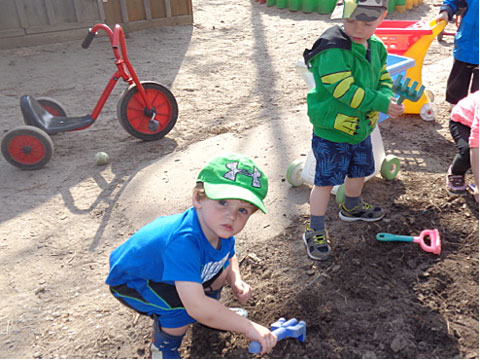
Next, the teachers created a planning web while asking the children what they knew and what they wanted to know about gardens. Below is a list of questions generated by the webbing activity.
| Things We Know About Gardens | Some Things We Want to Know |
|---|---|
| Gardens have flowers Carrots grow high Squirrels like them Need shovels to dig They are pretty We need seeds We see worms | How does a garden grow? Why are there worms under our garden? How do we plant watermelon and fruit? Why are plants green? Why do we need to give them water? Why do they have flowers? Why do bees sit on flowers? And why do they fall off? Who picks our food? |
Following the webbing process, the teachers asked some of the children where we could find our answers to these questions about gardens. Here are some of the places they suggested: a computer, books, a farmer, and us (the teachers). We then moved onto Phase 2, which involved seeking answers to our questions.
Phase 2: Developing the Project
Phase 2 involved a lot of hands-on, dirty work from the children and staff. Some of the children have gardens at home and were excited to share what they saw growing in them. The teachers asked the children what they would grow if they had their own garden.
Together the children and teachers created a chart of the many items they would plant in their gardens. It seemed that most of the children wanted to plant carrots, celery, lettuce, beans, watermelon, spinach, and flowers. From this chart the children were able to narrow it down to a few things. With our list in hand, we walked to a local store to pick up our seeds. We couldn’t find everything on our list, so the teachers read the names on the seed packages. The children and teachers discussed seeds that would do best in the sun and, knowing this information, we were able to pick out a few different types of seeds.
We began the hard work of preparing the gardens. Using a few familiar garden tools like small rakes and shovels, the children along with Deb started to break up the old hard soil around the tree. Deb then brought out the garden claw. This was a new way of showing the children how soil can be turned in a quick manner. Many of the children became interested in this tool. The teachers allowed each child the chance to explore the claw.
This seemed to spark many questions. Lincoln wanted to know what it was called, Laila asked why we had that tool, and Camilo wanted to know why the claw was so hard to push through the soil. While each child used the tools, the conversation about gardens grew. We received a huge bag of soil to use in the tire garden and large garden. We created an edge for the garden using large rocks that had been donated to the class. The rocks were very heavy, and the children needed to work together to carry them and place them in just the right spots.
Because it was still a little cold outside to plant our seeds, Thijm suggested to Mary that we plant some of the green beans and lettuce inside our classroom like he had done with his mom. He said you can then watch them grow until it is warm outside. The teachers prepared the materials, and the children took turns planting our seeds into pots. As the plants grew and got bigger, we noticed the weather got warmer, so the children and teachers worked together to transplant each pot into our tire garden outside.
Mary and a group of children got out the iPad and looked up different games and activities we could do to learn more about plants, how they grow, and gardening in general. Some of the children sat down at the open art table and drew pictures of how they saw seeds and plants. Their visual representations of seeds and plants became more detailed as their knowledge increased.
As the staff and children looked at many fun ideas on the iPad, this sparked some new conversations and inspired new questions from the children. The children wanted to know: How else can plants grow? Can they grow in just water or can they be started from old plants? We looked further into this and found it is possible to do both, so the children asked Dave, our cook, for some scraps from the kitchen. Dave was able to give us some tops of carrots, celery bottoms, and a potato. We started the scraps in containers with a little bit of water. We watched the changes in growth. At first we didn’t see much difference, but after a few days we started to see something growing. We watched as the carrots got hair, the celery began to shoot up a new stock, and the potato’s eye started to sprout all over. Once they were ready, we also planted them outside.
For our field study, we took the preschoolers back to look at the community gardens growing along Lincoln Road. We looked for familiar plants we saw growing in our gardens. Many of the children pointed out the flowers, fruits, and vegetables they have planted at home or the foods they enjoy eating. We explored how they used giant barrels to collect the rain water to use for watering the gardens. They also watched bees pollinating the garden plants. Once we returned to school, the children were excited to share all they had seen while visiting the gardens.
As the summer came closer to an end, we and the children were able to harvest some vegetables. First came the lettuce, because it was so healthy and the leaves were big. Zaim, John, and Ian were excited to pick the leaves, learning that we take or pull from the bottom and not the top. They carefully gathered enough leaves and took them to Dave, our cook, so he could wash them and prepare them for our salad for the center.
Although we had success with our lettuce, there were many plants that did not make it. The children noticed something was eating them. The children made several guesses about what was eating our plants because some had tiny brown spots on them, tiny holes, or they were gone from the garden. Then one morning Kaleb saw a bunny on the playground, and because bunnies like to eat carrots, lettuce, and other veggies, we figured it was enjoying all our hard work. The children also discovered two squirrels and some birds in the garden. However, these animals didn’t eat everything because our bean plants grew pretty tall, which gave the children the opportunity to pick a few to enjoy with lunch or just eat right off the vine.
Mary created a matching game that provided the children the opportunity to review their knowledge about different plants and how they grow. The children explored this activity when we first started our project and revisited it at the end. The children were able to place the fruit or vegetable correctly on the chart near the end of our project.
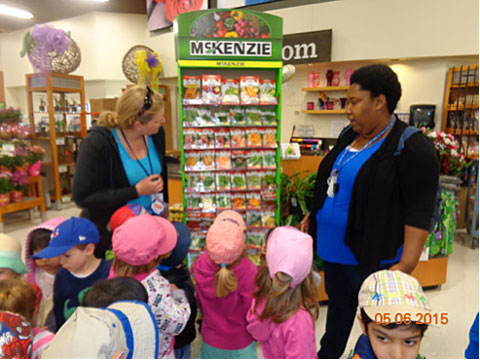
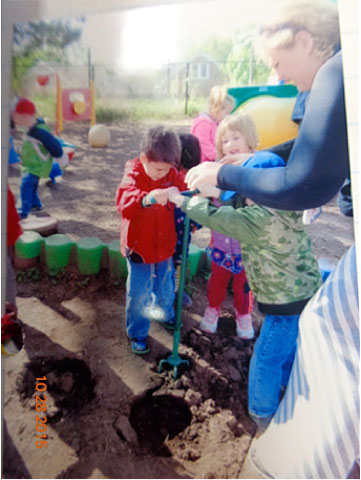


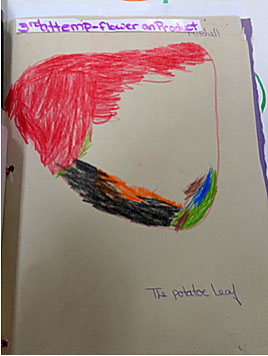




Phase 3: Concluding the Project
While wrapping up our project on gardens we revisited a lot of our learning with the children. To provide an overview of our learning for our families, we created a summary display board and a book compiled with photos, activities, and documentations.
We invited parents and families to take a closer look at our gardens as well as our project history board. Some parents were eager to share with us tips and stories of their gardening experiences. For example, Thijm’s mom, Barbara, commented that their home garden was doing well. Simone mentioned “rabbits actually ate our second batch of lettuce,” and Barbara shared how rabbits also ate the beets in their garden.
We tried to give Dave our beans to put in our lunch. We soon realized that John, Chloe, Cali, Melina, Camilo, and Laila had been eating all of them whenever they could. With that discovery, we decided to plant a bigger garden next year.
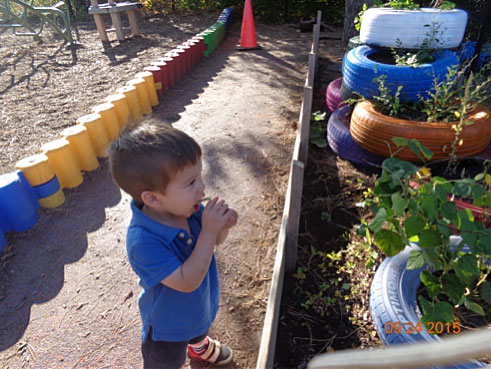
Teacher Reflection
Our preschool children benefitted from the Garden Project as they were able to show and understand how to plant and grow a garden. The children were able to learn and implement the knowledge they gained from the activities they explored. They learned about how important the weather is when one is caring for a garden. We quickly learned how our plants became tired looking and unhealthy from just one weekend of hot sun and no water. With hands-on experience, the children were able to learn the difference between weeds and growth, good soil temperatures, and insects that would help protect the growth from other insects wanting to damage it.
Mary’s reflection: It was amazing to see how one’s learning could start with a simple question. “What’s that?” This question Camilo asked led us to our Garden Project—learning how a little shoot coming up out of some dirt would intrigue the children on how they get their food and where it comes from. One activity I loved was the visual grid of where food grows. This grid was divided into four sections: vines, trees, under the soil, and on top of the soil. With all types of fruits and vegetables to choose from, the children placed the item where they thought they would grow. After two months of planting, caring for, and harvesting a garden, this activity looked a lot different the second time around. The children put all the fruits and vegetables in the proper growing section. Thijm was very excited to learn some foods grow on vines and how those vines just keep growing longer. He was able to make a connection on our latest trip to the pumpkin patch, discovering that pumpkins and squash grow on vines just like our beans. This in turn sparked a whole new conversation on farming.
Simone’s reflection: It was an eye-opening experience to see the children’s take on the growth of our vegetables throughout the project. The children created pictures of each stage of vegetable growth, starting with the seed. As we continued to care for our garden, some children were able to draw new pictures showing the stem coming out of the seed. One of the most interesting interactions I had during this project was with Ian. One day Ian arrived with a small tape measure in his hand ready to measure the height of our bean stocks. We discovered that our stalks were still quite tiny and the beans were very little and not ready to pick. Each day Ian and I would check on the garden to see how much they had grown. Many conversations between Ian and John took place over whether the beans were ready. John’s main interest was picking our beans to eat. Finally, the day came when our beans were plenty and we could harvest them. The children sat on the rainbow wall and stood beside the garden waiting for the first taste of homegrown green beans.
Deb’s reflection: It was fantastic to see all the children involved in some or all aspects of the Garden Project, from preparing the soil, creating the rock fence, planting seeds, weeding, and watering to harvesting and eating what we had grown. One of my favorite activities with the children was creating new plants from vegetable scraps. While researching how this could be done, I was surprised to see just how many different types of plants this could be done with, as well as how easy it was to get started. The children were so excited to watch the daily changes, and their excitement made it feel all the more worth it.

